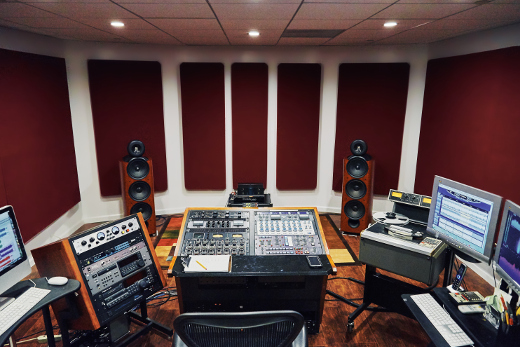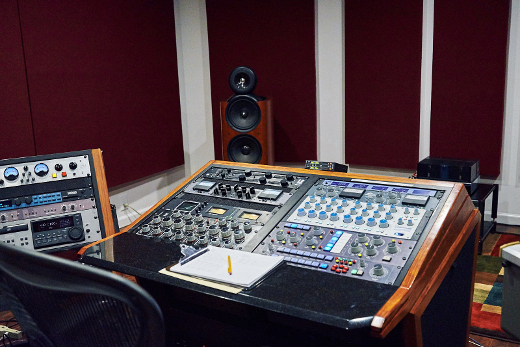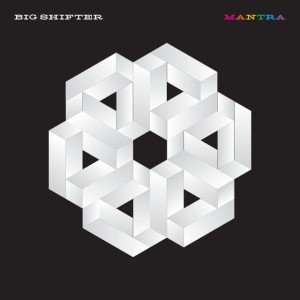Master Plan: Joe Lambert Mastering – Jersey City, NJ
Making a move is something Joe Lambert knows how to do – in more ways than one.
Lambert went solo in 2008, after a decade plus of mastering at bigger NYC houses. Hanging out his own shingle as Joe Lambert Mastering was a risk, but one that’s paid off as he built up a discography with the likes of Moby, Stevie Van Zandt, Of Montreal, and many many more.
Then it came time to make the next move – whether he liked it or not. When his longtime pro home base of 10 Jay Street told its tenants it was going condo, Lambert’s suite (along with several other music studios in the building), were officially on the endangered list.
It was time to panic or get practical, and Lambert did the latter. His investigation into the perfect next place took him across the Hudson River to Jersey City, but this move wasn’t a stretch for this mastering engineer who hosts a high percentage of attended sessions and also knows his vinyl.
To see why JC was perfect for JLM – and could very well be right for many more music mavens in the near future – get his perspective, in our latest “Master Plan.”
Facility Name: Joe Lambert Mastering
Website: http://www.joelambertmastering.com
Location: Jersey City, NJ
Clients/Credits: Moby, The National, Lindsey Stirling, Stevie Van Zandt, Sharon Van Etten, Animal Collective, Local Natives, City and Colour, Deerhunter, Toro Y Moi, Of Montreal, Stephen Sondheim, Darkside, Washed Out, Ian Hunter, Hiss Golden Messenger, Andrew Wyatt.
On the Move: We opened up JLM in DUMBO June of 2008. I wanted to find a place in Brooklyn but still be close to Manhattan. It was a fun neighborhood to be in. They recently changed the zoning, so the majority of the neighborhood is going residential.
The building we were in was one of them — they gave everyone three months notice to evacuate. I suspected it a little earlier, so I wanted to find a place before the end of last year. I wanted to be able to come in after the holidays and hit the ground running with the move behind me.
Quest for Space: I started looking around Brooklyn and Long Island City. First off, the prices seemed to have tripled since I was looking in 2008. More importantly, the few places I did like were all the kind of buildings I could see deciding to go residential in the near future. I was hesitant to build another place in that situation.
I saw an article in the NY Times about how Jersey City is starting to blow up, mainly because Brooklyn has become maxed out and people no longer can afford it. So I checked it out and was really liking it. I found a great spot right next to the Grove PATH station. It’s 8 minutes from Manhattan and is the perfect size and situation.
One of the big selling points for me was how helpful the building owners were with the buildout. They paid for the majority of the build! It saved me so much money. It’s a really good situation lease-wise for us and it’s a commercial property/workspace that I don’t have to worry about going co-op.
Improving the Room: This time I was able to build the room to the exact size I wanted. I loved the room I had at Trutone, (which was designed by John Storyk) so I wanted the same dimensions.
I wasn’t able to do that with the DUMBO room because of limitations in the space. The old room had a high loft ceiling. We installed a series of clouds that helped, but I never loved it. This time we installed a lower acoustic panel “drop” ceiling that I like much better. Luckily I was able to use the majority of acoustic panels that Taytrix built for the last room so that saved a lot of money. I also put in better bass trapping for the new room. The low end in this room is noticeably better. It’s really tight! I’m very happy with it.
How to Move Studios…Without Getting Overwhelmed: I WAS overwhelmed! It was very stressful. It’s so difficult because you’re looking for the right area/space. It’s not like you can just pick a room with a nice view somewhere, good parking and set up your laptop. There are so many things to consider while making it work financially within the realities of the current music industry.
On top of that I still had to get all my day-to-day work done. I’m just starting to feel normal again.
The good news is we have a better facility now with room to grow. The only advice I would give someone is to pick an area you think will work long term. And try and plan ahead, because these things always take at least twice as long as you are told by contractors, architects and such.
Perfect Attendance: I have always done a high percentage of attended work. I try to be personable with my clients — maybe that’s part of it.
We have always encouraged those who can attend to do it. Especially if you haven’t made a record before. It’s great. You get to listen to your music in an environment that is likely to be the best-sounding experience you’re going to have. This is a very big reason we built the type of studio where we did, the way we did.
Master Mind: I am a life-long musician and I also worked for several years in high end audio. It helped me develop a better appreciation and understanding of the difference between something sounding good and something sounding really magical.
While I was at Full Sail they would bring in different hot shot engineers to play us their mixes. They sounded really good, but not like the records I was listening to so I mentioned it to them and they of course said, “It’s not mastered yet”. So I asked, “What do you mean?” and the more I started engineering I felt that my skill set would work well in that field. Then I put my head down and starting working my butt off at it for the last 19 years or so.
It’s easy for me to stay passionate about mastering records. I get to work with so many different people. Many have become friends that I’ve made records with for years. I honestly feel like I’m just hitting my stride. I love being involved in the creative process.
How I Hear It: My approach is “Serve The Song.” What I mean by that is to simply listen to it and do whatever I can to make it as listenable or enjoyable as possible. Most decisions I make feel like common sense…a certain balance, dynamic range and such.
Then I have to take into account if the artist has a specific concern for this record. For example, sometimes they ask me to make it heavier in low end than normal or a little brighter or more vocal centric. To me there is a place where I think it’s just “right.” Most of the time they say OK, but sometimes they want more (or less) of something so I will let them hear the difference. Then we make a decision and go from there.
Ultimately it’s someone else’s record so I want them to be happy. If I do think we are going too far in a specific direction I always let them know, but if they say, “We like it,” then that’s what I give them. I am not trying to put any particular “Joe Lambert” stamp on it. Whatever it takes and nothing more.
Key Personnel: Diana Zinni is my studio manager. She handles all the things I can’t! I have a specific way I like to have things work and run and she does a fantastic job. Roman Vail is our staff engineer. Roman was an assistant for me for several years while I worked out of Trutone Mastering. He came with me when I opened up in 2008.
When running a small business you have to make sure the people you hire can handle many different tasks and are of course reliable. A big part of what we do for our clients is thinking ahead for them, asking questions they may not have thought about such as: “Are you doing vinyl, instrumentals, Mastered for iTunes… If not should you and what’s involved?”
A portion of our clients are independent and may not have thought about all of this but it may be the difference between their music being heard or not. I’m very lucky to have both of their help and skills.
Top Gear: All of my gear is essential to me! I have one of the first Sontec Equalizers ever made. It’s actually a four-channel unit designed to give you the ability to run a separate stereo pair out to the lathe so the EQ would be pre cutter head. I had a new power supply built for it and completely updated the wiring and also had Burgess the designer go through all the op amps to make sure it was up to snuff. It sounds so good and allows me to work quickly and mold things in ways most equalizers just can’t do.
My other most-used EQ at the moment is the Buzz mastering EQ. It has the feel and top end of the Sontec with more of a tonal quality of a Massive Passive. It’s really sweet sounding.
I have my Maselec Console that I love because it’s ultra quiet, plenty of headroom, lots of inserts and some unique features like the elliptical filter and the stereo width control which also come in handy for cutting.
I have my Kef Reference 207 monitors with a pair of rebuilt McIntosh 2100 amps. We also use the Manley mastering version of the Vari Mu, Prism EQ and Compressor, and a couple of other toys. An ATR that is in perfect shape and sounds wonderful.
The Anomod ATS-1 tape simulator is also a great thing to have for mastering certain records. Especially songs with mostly electronic sounds, it can help slow down transients and glue things together in a very nice way.
Vinyl Kind: I really started cutting vinyl when I went to work at Trutone mastering around 2003. The owner Carl Rowatti had been cutting records most of his life and that was a big part of their business. I was fortunate to learn from him on a VMS 70 with a Zuma computer. Once you learn the ins and outs of that machine and how to get the best cut, it’s the best sounding machine out there in my opinion.
The challenges with vinyl are mostly physical. You are always trying to balance the length of the side with the depth of cut and volume. Most people only think how loud is it going to be, and there is often educating clients new to vinyl on how best to divide up the material to get the best sounding, loudest cut. The challenge with some clients is to get them to understand the whole process involved to making records including the plating and replicating. It’s going to take several weeks, so plan ahead.
Off Duty: I honestly don’t listen to much music during the week outside of work now. I master 40-50 different songs a week so my head and ears just need a break.
Usually I come home and play guitar to relax. It’s my therapy. I also have a band (Big Shifter), we just finished up our first full length.
When I do listen it varies a lot, it really just depends on the mood I’m in. I love music so much that I feel guilty if there are things I’m not familiar with, so I really try to check out as much as I can. With that said sometimes I just need to listen to The Who or Soundgarden — then I’m pretty happy.
What I Wish Everyone Understood About Mastering: That it’s one step in the chain.
There are times when after mastering a project there is a very dramatic difference from what you came in with, and everyone is excited and eager to share it with the world.
But if you don’t like your vocals, don’t like the tempo, don’t like the drummer, you’re probably not going to like them when the mastering session is done either. I like to communicate with my clients beforehand to make sure we’re on the same page, to give ourselves every opportunity to finish up with something great.
Listen Better: Get some good speakers. So many people only listen on headphones or computer speakers now. They are really missing out, literally.
I love the convenience of headphones sometimes as well, but there is no comparison to a good pair of speakers. You will have a far better idea of what is going on balance wise with your work, and it will be more fun.
— Joe Lambert
Please note: When you buy products through links on this page, we may earn an affiliate commission.











TK Gringer
March 16, 2015 at 8:39 pm (10 years ago)Joe Lambert is a master! Nice article. Look forward to visiting the new studio